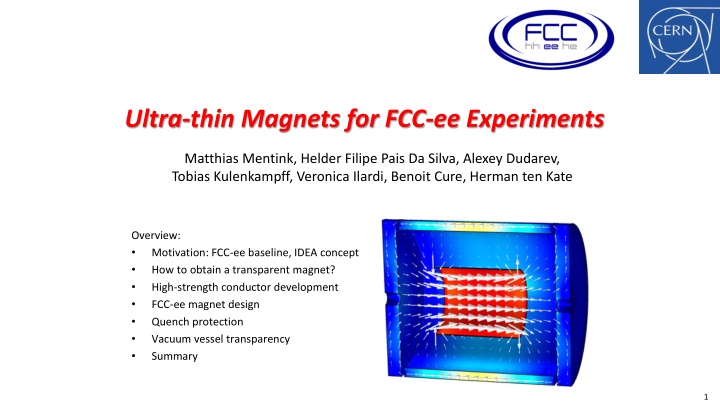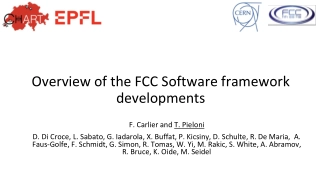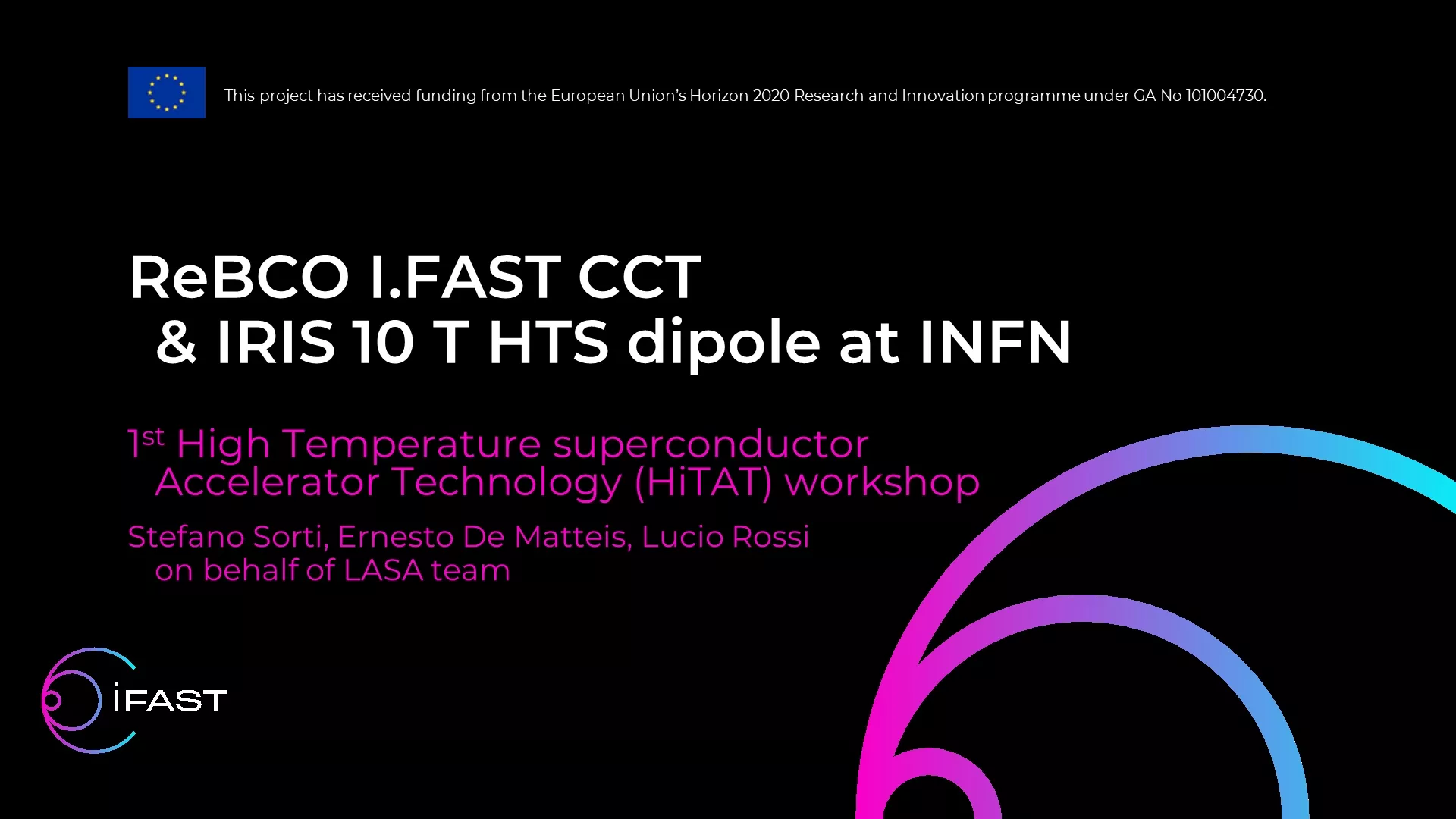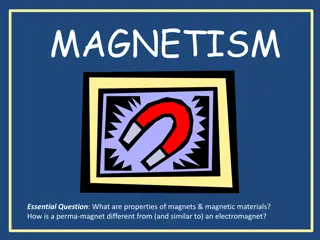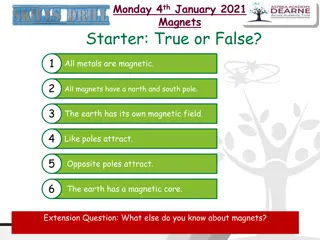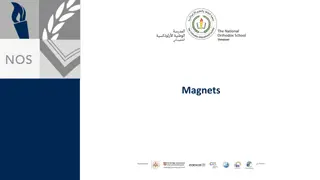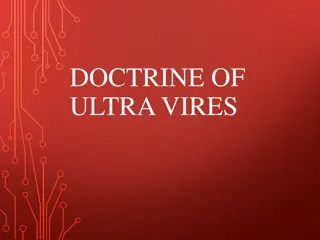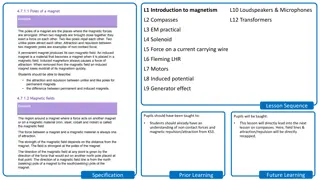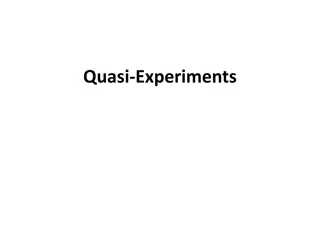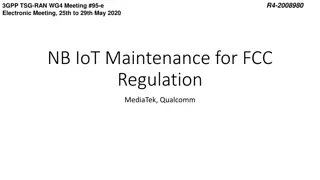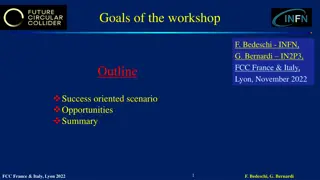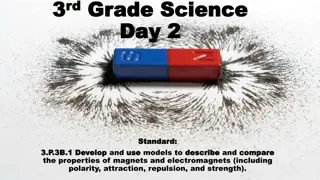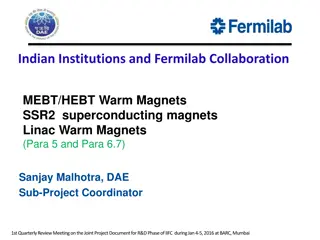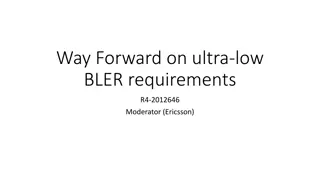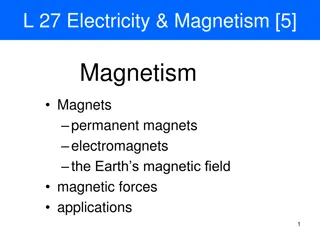Development of Ultra-Thin Magnets for FCC-ee Experiments
Overview of the motivation, concept, and design principles behind the development of ultra-thin magnets for FCC-ee experiments, focusing on obtaining transparent magnets, high-strength conductor development, magnet design, quench protection, and vacuum vessel transparency. The project aims to create magnets with optimal magnetic field distribution and minimal stray fields, requiring transparent cold mass and vacuum vessel. The approach involves using high-strength conductors and innovative welding techniques.
Download Presentation

Please find below an Image/Link to download the presentation.
The content on the website is provided AS IS for your information and personal use only. It may not be sold, licensed, or shared on other websites without obtaining consent from the author.If you encounter any issues during the download, it is possible that the publisher has removed the file from their server.
You are allowed to download the files provided on this website for personal or commercial use, subject to the condition that they are used lawfully. All files are the property of their respective owners.
The content on the website is provided AS IS for your information and personal use only. It may not be sold, licensed, or shared on other websites without obtaining consent from the author.
E N D
Presentation Transcript
Ultra-thin Magnets for FCC-ee Experiments Matthias Mentink, Helder Filipe Pais Da Silva, Alexey Dudarev, Tobias Kulenkampff, Veronica Ilardi, Benoit Cure, Herman ten Kate Overview: Motivation: FCC-ee baseline, IDEA concept How to obtain a transparent magnet? High-strength conductor development FCC-ee magnet design Quench protection Vacuum vessel transparency Summary 1
Motivation: FCC-ee baseline, IDEA concept Solenoid Return yoke B [T] FCC-ee detector baseline with ultra-thin solenoid [1,2]: IDEA concept [3,4] Optimal magnetic field distribution: Significant field where it is needed (tracker, instrumented return yoke) Very little parasitic field (calorimeter) Barely any stray field outside yoke Minimal stored magnetic energy Reduced magnet system cost (> 2x) 3D representation: Solenoid + yoke IDEA concept [3,4] 6 B [T] Radial position [m] 5 4 But: Particles tunnel through magnet & vacuum vessel before reaching calorimeters Cold mass and vacuum vessel must be as transparent as possible 3 2 1 0 0 1 2 3 4 5 6 7 Axial position [m] Stray field at z = 0 Magnetic field map 2 M. Mentink et al., Ultra-thin Magnets for FCC-ee Experiments, FCC-France, 14/11/19
How to obtain a transparent magnet? Design principle: ATLAS Central Solenoid [5] CMS High-strength aluminum- stabilized Nb-Ti conductor [7] Aluminum-alloy honey-comb structure in vacuum vessel [8] Build on top and reach beyond past research and experience [5]: Aluminum-based cold mass and vacuum vessel (Radiation length X0= 89 mm, nuclear interaction length = 397 mm [6]) High-strength aluminum-stabilized Nb-Ti superconducting conductor [7] High stress-tolerance gives reduced cold-mass thickness Optimized vacuum vessel [8] Smart mechanics for reduced vacuum-vessel thickness 3 M. Mentink et al., Ultra-thin Magnets for FCC-ee Experiments, FCC-France, 14/11/19
High-strength conductor development Stir-friction weld Electron- beam weld 7000 series alloy Nb-Ti/Cu Rutherford cable: 20 x 1.35 mm strand 30 mm EN AW-7020 EN AW-7068 Al+0.1 wt% Ni stabilizer Al+0.1 wt% Ni stabilizer stabilizer Al+0.1 wt% Ni Al+0.1 wt% Ni stabilizer 10.5 mm (Including insulation) Welding technique #1: Electron-beam welding [10,11] Welding technique #2: Stir-friction welding [11] Proposed conductor for FCC-ee High-strength conductor: Same principle as CMS conductor [7] but stronger alloys: Nickel-doped aluminum instead of pure aluminum [5,9], 7000 series aluminum-alloy instead of 6000 series [10] Test-samples fabricated using two different welding techniques, to be measured: Electron-beam welding [10,11] Stir-friction welding [11] 4 M. Mentink et al., Ultra-thin Magnets for FCC-ee Experiments, FCC-France, 14/11/19
FCC-ee magnet design Nb-Ti/Cu Rutherford cable: 20 x 1.35 mm strand Property Value Magnetic field in center [T] 2 7000 series alloy goes to 280 MPa Cold mass length [m] 6 Al+0.1 wt% Ni stabilizer, yields at 100 MPa Cold mass thickness [mm] 30 Stored magnetic energy [MJ] 160 Cold mass volume [m3] 2.5 Magnet properties: 2 T over 4 m free bore, 6 meter length gives 160 MJ Cold mass volume: 2.5 m3, weight: 7700 kg Cold mass [t] 7.7 Energy density [kJ/kg] 21 Operating current [kA] 20 Conductor in the magnet: Conductor: 77% Aluminum, 5% Copper, 5% Nb-Ti, 13% G10 Current sharing temperature at peak field (3.2 T): 6.5 K Peak stress in the conductor: 280 MPa Energy density: 21 kJ/kg Challenging, but very valuable to have! 6 B [T] Radial position [m] 5 4 3 2 1 0 0 1 2 3 4 5 6 7 Axial position [m] Cold mass transparency: 0.46 X0, 0.09 5 M. Mentink et al., Ultra-thin Magnets for FCC-ee Experiments, FCC-France, 14/11/19
Quench protection Fast dump resistor (50 m ) 20 kA power supply Slow dump switch Failure case Hotspot temperature [K] 90 Magnet (0.815 H) Nominal quench protection Without heaters 150 Without energy extraction 120 Fast dump switch Slow dump diodes No heaters, no extraction > 500 In case of quench (Calculated with Quench 2.7 [12]) Magnet protection: Quench heaters and energy extraction VExtractor,Max = 1000 V 77% extraction of stored magnetic energy Further scope for improvement: Axial aluminum strips, for cooling and quench propagation Quench detection and protection will be designed in a redundant manner Magnet is protected, except for most extreme failure scenario Powering + Protection circuit Current discharge, nominal protection Hotspot temperature, nominal protection 6 M. Mentink et al., Ultra-thin Magnets for FCC-ee Experiments, FCC-France, 14/11/19
Vacuum vessel transparency Component (Effective) thickness [mm] Atmospheric pressure Inner shell 1.3 Vacuum 50 K inner thermal shield 0.35 Inner shell: Tensile stress (less challenging) 50 K outer thermal shield 0.35 Outer shell (honey-comb) 4.0 Atmospheric pressure Total 6.0 Outer shell: Compressive stress with buckling potential (more challenging) Vacuum vessel thickness, aluminum alloy with honey-comb structure Vacuum vessel challenge: Outer shell more challenging than inner shell: Compressive stress with potential to buckle Honey-comb structure found most optimal to prevent buckling [8] With aluminum-alloy Al-5083-O: 6 mm thickness in total, gives 0.07 X0, 0.013 Outer shell reinforcement options [8] 7 M. Mentink et al., Ultra-thin Magnets for FCC-ee Experiments, FCC-France, 14/11/19
Summary FCC-ee IDEA Baseline design, 2 T field over 4 m free bore + 6 m length Optimal distribution of magnetic field > 2x reduction in cost of magnet system expected Challenge: Magnet transparency below one radiation length required B [T] Conductor development High-strength conductor using high-strength aluminum alloys + Nb- Ti/Cu Rutherford cable, with enough stabilizer for quench protection Test samples were produced to be measured, using two different welding techniques Resulting magnet: No showstoppers from mechanics and quench protection perspective Cold mass: 0.46 X0, 0.09 , with high-strength conductor Vacuum vessel: 0.07 X0, 0.013 , with honey-comb structure Aggressive design, combined radiation length (0.53 X0), meets the target Promising, experimental demonstration is needed 8 M. Mentink et al., Ultra-thin Magnets for FCC-ee Experiments, FCC-France, 14/11/19
References [1]. M. Mentink et al., FCC-ee, first look at detector magnet concepts , FCC-ee 2nd Detector Requirements Workshop, 23/11/16 [2]. H. ten Kate et al., Detector Magnets for FCC-ee-eh-hh , presented at FCC week 26/6/19 [3]. https://fcc.web.cern.ch/Pages/A-refreshing-IDEA-for-FCC-ee.aspx [4]. M. Dam et al., FCC-ee Detector Requirements and Specific Designs , presented at FCC week 2017 [5] A. Yamamoto et al., Design and Development of the ATLAS Central Solenoid Magnet , IEEEE Trans. Appl. Supercond. 9, p. 852 (1999) [6] http://pdg.lbl.gov/2009/AtomicNuclearProperties/HTML_PAGES/013.html [7] B. Blau et al., The CMS conductor , IEEE Trans. Appl. Supercond. 12, p. 345, (2002). [8] H. Da Silva et al., Ultra-thin, Radiation Length Optimized, Metallic Cryostat for a 2T, 4m bore Detector Solenoid , presented at ICEC-ICMC, Sept. 6 (2018) [9] K. Wada et al., High-Strength and High-RRR Al-Ni Alloy for Aluminum-Stabilized Superconductor , IEEE Trans. Appl. Supercond. 10, p. 1012 (2000) [10] S. Sgobba et al., Towards and Improved High Strength, High RRR CMS Conductor , IEEE Trans. Appl. Supercond. 16, p. 521 (2006) [11] T. Kulenkampff et al. Conceptual Development of a Novel Ultra-Thin and Transparent 2 T Superconducting Detector Solenoid for the Future Circular Collider , IEEE Trans. Appl. Supercond. 29, p. 4500405 (2019) [12] Van Nugteren, Quench Simulation Code for Solenoids , Tech. Rep. CERN, (2011) 9 M. Mentink et al., Ultra-thin Magnets for FCC-ee Experiments, FCC-France, 14/11/19
